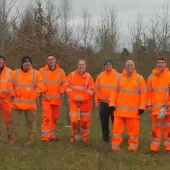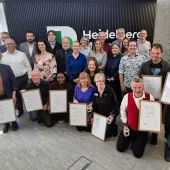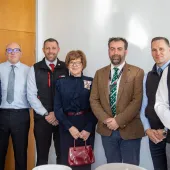Creative Quarry Restoration for Future Planning Success

First published in the June 2019 issue of Quarry Management as A Lasting Positive Legacy
Demonstrating creative restoration for future planning success. Aggregate Industries highlight the importance of collaboration with key stakeholders
With quarries having such a long life span, it is easy to forget that the extraction of minerals from the ground is only ever a temporary use of the land. While what we do with an operational site is important, restoring the land at the end of the quarrying process is vital in order for it to be safe, functional, and of benefit to the local community.
Restoration comes in a multitude of guises. It can mean simply filling in the site and returning the land to its original state, or in other cases, restoration might meet the needs of the local community through the creation of new recreation space or even space for housing development. Whatever the circumstances, being creative and meticulous with restoration planning not only gives us the opportunity to restore the environment, but to improve on it. This means doing more than announcing the supposed benefits of the restoration works purely to tick a box – it requires substantial planning to demonstrate how the operator is going to achieve the finished article and prove its worth to the area.
Let us take biodiversity as a measure of success. Restoration plans must not only profess that we want to build something to attract wildlife, but showcase expert knowledge of what flora and fauna work well together, what specifically is needed to bring wildlife to the site, and what the site will look like after one year, five years, and 50 years. It requires planning for ongoing maintenance and funding to make sure the restoration – be it for a nature reserve, woodland or wetland – is a long-term success.
Sometimes this requires us as operators to take a step back and look at the bigger picture. While sustainability and wanting to do right by the local community come with the territory of being in the quarrying industry, we are also delivering significant landscape-scale biodiversity benefits. We are increasingly working with partnerships to ensure that restoration schemes achieve their maximum potential and demonstrate both value to the local community and the environment, and longevity.
Operators also need to demonstrate a deep understanding of every piece of legislation that will be faced along this journey – a challenging task given more and more stringent regulations and standards which need to be met are put in place year after year. Through liaison committees we ensure that we communicate effectively with the local community to minimize impacts during the period of operation and to deliver a tailor-made restoration plan that benefits all parties.
One such example of successful collaborative working between the operator, nature conservation organizations, and the local community is the newly opened Ripon City Wetlands, which lies between the Ripon Canal and the river Ure. The wetlands operated as a working quarry until very recently. Now, managed by Yorkshire Wildlife Trust and supported by Aggregate Industries, this large site has been transformed into a nature reserve teeming with wildlife.
The journey from quarry to wetland started in 2003, when Aggregate Industries bought the quarrying rights from Brown and Potter, who owned the site. Consultation betweent, Aggregate Industries and the Trust worked with Dr Phil Fermor of Middlemarch Environmental to progressively restore the site until its opening in May 2019.
The restoration of the site has involved – amongst many other things – the movement of several hundred thousand cubic metres of soil and overburden to create the wetlands. More than 1,800 trees have been planted as part of the restorative works and, in one of the site’s reed beds, more than 10,000 reed plugs were planted. Expert inputs mean that the mosaic of habitats at Ripon City Wetlands works for wildlife. The canal reed beds are specifically designed to create the maximum amount of reed bed edge for feeding bitterns, and the strip of fen meadow that runs along its edge was made by spreading green hay and hand-collected seeds from Yorkshire Wildlife Trust’s nearby Staveley Nature Reserve. With careful management through late summer cutting, a wide variety of wildflowers and plants is likely to flourish and create the perfect environment for a variety of insects. The restoration scheme has also delivered high-grade agricultural land and a new sailing facility on the Newby Hall Estate for the White Rose Sailing Club.
Such comprehensive works do come at a cost – the Ripon restoration cost approximately £800,000, including a 50-year aftercare endowment payment to Yorkshire Wildlife Trust of around £250,000 to ensure the proper long-term management of the wetland nature reserve.
However, while this cost is by no means inconsiderable, committing to the upkeep of former sites makes good business sense in addition to the obvious sustainability benefits. By demonstrating living examples of what we can achieve through working collaboratively with experts in their respective fields, and by considering the restoration process as early as possible in the quarry application stage, we greatly increase our chances of ensuring the support of landowners and mineral planning authorities, and, vitally, building strong relationships within the local community. This means planning applications have a greater chance of being approved, as we have demonstrated our ability to work with key stakeholders and deliver a lasting positive restoration legacy.
It is not unreasonable to say that the future of our industry is dependent on our ability to not only work sustainably, but do what we can to benefit the lives of nearby residents – human or otherwise. By recognizing the need to forge partnerships that allow us to restore retired sites to the best of our collective abilities, we are not just benefitting stakeholders at the end of a quarry’s life, we are also guaranteeing supply for our customers for the foreseeable future through securing future planning applications.
- Subscribe to Quarry Management, the monthly journal for the mineral products industry, to read articles before they appear on Agg-Net.com








